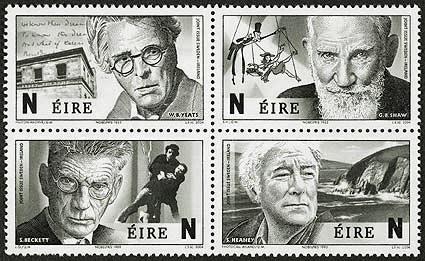Time to see more women on Irish stamps?

Why are there so few women philosophers? Have women been too busy hanging up washing and sorting socks? A wonderful luxury, philosophy's place on the hierarchy of needs depends on whether you are female and if there is good drying weather. But if we ask why there so few women on Irish stamps then the answer is less tangible than the Beaufort scale.
[Pictured: Four Irish stamps from 2004 that honour the Irish Nobel Prize winners for Literature ]
Since 1929, at a rough count, over 300 men have had their achievements celebrated on Irish stamps. Look for the tribute to women and you might find about 30. This figure is not absolute since some women feature more than once - the ubiquitous Mother Theresa for example. We asked An Post's head of philately, Barney Whelan about the reasons for this gap.
"It is not due to any subterfuge by An Post," explains Whelan. "We reckon it simply reflects a society where women didn't have a vote and had to give up jobs when they married. Women in this State were effectively invisible for much of the period of early stamp output," says Whelan. Hmm, that was the last century surely?
"Stamps do chart a society's development," says Whelan. However a quick glance through the stamp output for the past 80 years 'reflects' a society of white, Catholic, male golfers who listen to traditional Irish music. We are eleven years into a new century and the number of women represented on stamps is still woefully small. Should we care?
Yes according to Dr Mary McAuliffe at the School of Social Justice, UCD. "It is not unusual that An Post would have 300 men and only 30 women on their stamps as women's contribution to society, in most arenas, be they political, cultural or economic has, and continues, to be undervalued," says McAuliffe. In the recording of history women's contribution "is often deemed unworthy of celebration, rendered invisible and or unimportant" says McAuliffe. So, while women are being marginalised in the public sphere, the analysis by An Post that this 'reflects society' is technically true, but does it make it right?
"This is changing with the growth of a more balanced, gendered approach to history, but organisations like An Post obviously still seem to think that this 'male-centred' celebration of achievement in Ireland 'truly' reflects Irish society. I would argue that it does not and it is incumbent on An Post to correct this false record," McAuliffe says.
While technology, science and cultural contributions to society are celebrated on stamps Whelan says there is no "intent" in not featuring more individual women. Anyone can make a suggestion to the Philatelic Section in the GPO. The idea goes go to an advisory committee of experts which includes stamp dealers and collectors. Anniversaries and commemorations are well received. Appropriate themes for a year are decided. "The Government is assiduous in seeking suggestions from all its departments and agencies in the country," says Whelan.
The filtered list is sent to cabinet for approval, usually in the autumn. An Post is now putting together the stamp programme for 2012.
So if there is a woman whose achievements should be remembered and celebrated then make sure to put her onto the list. The criterion of 'significant anniversary' needs to be reconsidered says McAuliffe "or else we might wait another hundred years to see more women on stamps."
"Achievement itself should be enough," she adds. International Women's Day is on 8th March this year, time we saw more women on Irish stamps?
What about the president of the Institute of Physics Jocelyn Bell Burnell; architect and designer Eileen Gray; artist Alice Maher; theatre director Garry Hynes; playwright Marina Carr; musician Sharon Shannon; union leader and labour agitator Mary Harris (Mother Jones); singer Sinead O'Connor; human rights lawyer Rosemary Nelson; suffragette Hanna Sheehy Skeffington; Nobel winner Mairead Corrigan; Nobel winner Betty Williams. Make your own list and send it to Barney Whelan, An Post Philately Section, GPO, O'Connell Street, Dublin 1.
This article first appeared in NewsFour.
